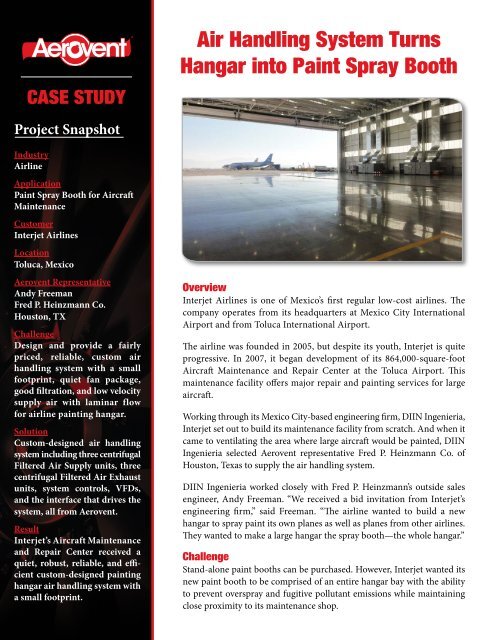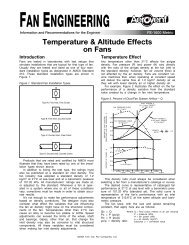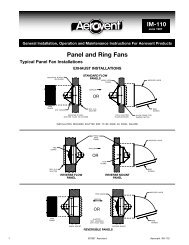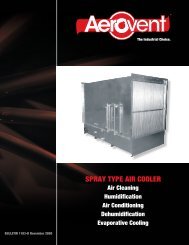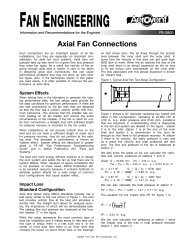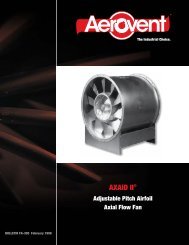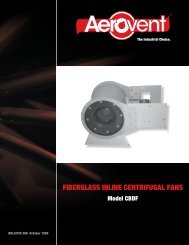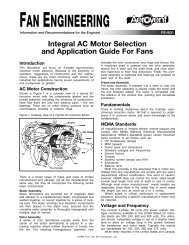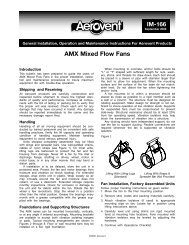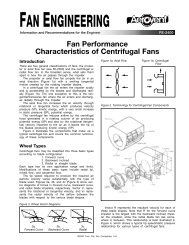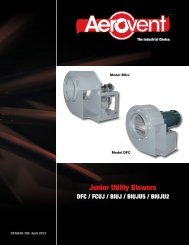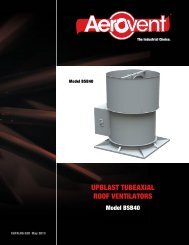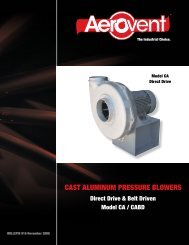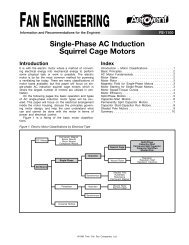Airplane Hangar Paint Spray Booth - Aerovent
Airplane Hangar Paint Spray Booth - Aerovent
Airplane Hangar Paint Spray Booth - Aerovent
You also want an ePaper? Increase the reach of your titles
YUMPU automatically turns print PDFs into web optimized ePapers that Google loves.
®<br />
CASE STUDY<br />
Project Snapshot<br />
Industry<br />
Airline<br />
Air Handling System Turns<br />
<strong>Hangar</strong> into <strong>Paint</strong> <strong>Spray</strong> <strong>Booth</strong><br />
Application<br />
<strong>Paint</strong> <strong>Spray</strong> <strong>Booth</strong> for Aircraft<br />
Maintenance<br />
Customer<br />
Interjet Airlines<br />
Location<br />
Toluca, Mexico<br />
<strong>Aerovent</strong> Representative<br />
Andy Freeman<br />
Fred P. Heinzmann Co.<br />
Houston, TX<br />
Challenge<br />
Design and provide a fairly<br />
priced, reliable, custom air<br />
handling system with a small<br />
footprint, quiet fan package,<br />
good filtration, and low velocity<br />
supply air with laminar flow<br />
for airline painting hangar.<br />
Solution<br />
Custom-designed air handling<br />
system including three centrifugal<br />
Filtered Air Supply units, three<br />
centrifugal Filtered Air Exhaust<br />
units, system controls, VFDs,<br />
and the interface that drives the<br />
system, all from <strong>Aerovent</strong>.<br />
Result<br />
Interjet’s Aircraft Maintenance<br />
and Repair Center received a<br />
quiet, robust, reliable, and efficient<br />
custom-designed painting<br />
hangar air handling system with<br />
a small footprint.<br />
Overview<br />
Interjet Airlines is one of Mexico’s first regular low-cost airlines. The<br />
company operates from its headquarters at Mexico City International<br />
Airport and from Toluca International Airport.<br />
The airline was founded in 2005, but despite its youth, Interjet is quite<br />
progressive. In 2007, it began development of its 864,000-square-foot<br />
Aircraft Maintenance and Repair Center at the Toluca Airport. This<br />
maintenance facility offers major repair and painting services for large<br />
aircraft.<br />
Working through its Mexico City-based engineering firm, DIIN Ingenieria,<br />
Interjet set out to build its maintenance facility from scratch. And when it<br />
came to ventilating the area where large aircraft would be painted, DIIN<br />
Ingenieria selected <strong>Aerovent</strong> representative Fred P. Heinzmann Co. of<br />
Houston, Texas to supply the air handling system.<br />
DIIN Ingenieria worked closely with Fred P. Heinzmann’s outside sales<br />
engineer, Andy Freeman. “We received a bid invitation from Interjet’s<br />
engineering firm,” said Freeman. “The airline wanted to build a new<br />
hangar to spray paint its own planes as well as planes from other airlines.<br />
They wanted to make a large hangar the spray booth—the whole hangar.”<br />
Challenge<br />
Stand-alone paint booths can be purchased. However, Interjet wanted its<br />
new paint booth to be comprised of an entire hangar bay with the ability<br />
to prevent overspray and fugitive pollutant emissions while maintaining<br />
close proximity to its maintenance shop.
CASE STUDY<br />
®<br />
For its painting hangar, Interjet wanted custom air handling units with a<br />
small footprint, quiet fan package, good filtration, and low velocity filtered<br />
supply air with laminar flow. “They wanted small, quiet, dependable, fairly<br />
priced units that could run every day,” Freeman said.<br />
Laminar airflow was important to the success of this project. “Interjet<br />
wanted straight-line airflow,” said Freeman. “They didn’t want the air<br />
swirling as it came out of the duct because that could lead to overspray.”<br />
Toluca International Airport<br />
Maintenance & Repair Center<br />
Filtered Air Supply Units<br />
Interjet also wanted the capability to scrub the air before it left the<br />
building. This meant that the paint hangar’s exhaust air needed to filter<br />
out particulates and paint and/or solvent-based hydrocarbon compounds.<br />
To accomplish this, <strong>Aerovent</strong> engineers had to design a high-volume,<br />
low-velocity air handling unit with inline filtration capable of maintaining<br />
slightly positive pressure within the painting hangar and less than a 1-inch<br />
differential across the filters. In addition to these specifications, Interjet<br />
also required its new facility to comply with U.S. codes and standards for<br />
this type of facility.<br />
Solution<br />
Fred P. Heinzmann Company supplied a custom-designed air handling<br />
system including three centrifugal Filtered Air Supply units, three centrifugal<br />
Filtered Air Exhaust units, system controls, VFDs, and the interface that<br />
drives the system, all from <strong>Aerovent</strong>. The <strong>Aerovent</strong> design team worked<br />
with Interjet and DIIN Ingenieria to design the entire air handling system.<br />
On one side of the hangar, three Air Supply units pull in outside air<br />
through filters that remove airborne particulates, such as dirt, dust, and<br />
pollen. Each of these double width, double inlet, VFD controlled 44.5-inch<br />
centrifugal blowers run at a top speed of 657 RPM to produce 44,000 CFM<br />
at 1-inch of pressure for a total of 132,000 CFM of supply side air. Fabric<br />
duct socks connected to a common supply plenum disperse the air from<br />
the top of the hangar. The air travels toward the floor, picking up paint<br />
spray along the way.<br />
On the other side of the hangar, three Air Exhaust units pull air through<br />
grate-covered ducts located in the floor. The air passes through a series of<br />
filters—disposable pre-filters that capture paint and particulates and two<br />
stages of carbon filters that remove hydrocarbons—through the centrifugal<br />
blowers, and is discharged to the outside. Each of these single width, single<br />
inlet, VFD controlled 55-inch diameter centrifugal blowers run at a top<br />
speed of 720 RPM to pull 44,000 CFM for a total of 132,000 CFM of<br />
exhaust side air.<br />
With the supply and exhaust units operating as a cohesive system to provide<br />
ceiling-to-floor laminar airflow, the VFDs for both supply and exhaust<br />
units are adjusted to maintain a slightly positive pressure (less than 0.1<br />
inch W.C.) within the hangar. “If there’s too much positive pressure, it
will force the dirty, contaminated air to the outside before it is adequately<br />
filtered,” said Freeman. “There needs to be a certain differential across the<br />
filters for them to be effective.”<br />
®<br />
Maintaining the ideal pressure inside the hangar is challenging because<br />
of the large door where aircraft enter and exit. Therefore, the door<br />
must remain closed while planes are being painted. “The system handles<br />
132,000 CFM on the supply side and 132,000 CFM on the exhaust side,”<br />
Freeman said. “It’s almost neutral, pressure-wise. We created an envelope<br />
of fresh filtered air around the plane.”<br />
CASE STUDY<br />
A quiet system with a small footprint was also important to Interjet.<br />
“These units were engineered to run at lower speeds for quiet operation<br />
and used belt-driven blower to make the fan package as compact as<br />
possible,” Freeman said.<br />
Interjet personnel set the speed of the fans. In addition to temperature<br />
and humidity conditions, the pressure differential across the filter system<br />
is closely monitored. When this pressure exceeds 1 inch, an alarm indicates<br />
that a filter change is necessary. “When the filters are new and clean, the<br />
blowers can operate at lower speeds because there’s less resistance to the<br />
airflow,” said Freeman. “But as the filters load up, fan speeds need to be<br />
increased to recover the pressure lost across the dirty filters.”<br />
Results & Benefits<br />
<strong>Aerovent</strong> supplied the custom air handling equipment, supporting system<br />
components, and the engineering expertise to create Interjet’s air handling<br />
system. However, the fan company’s involvement in this project transcends<br />
merely manufacturing and supplying equipment. Not only did <strong>Aerovent</strong><br />
design Interjet’s entire paint hangar air handling system, the company<br />
overcame challenges to do so. While the original request for bid specified<br />
extremely unique requirements, <strong>Aerovent</strong> worked with Interjet to overcome<br />
these challenges and meet their exact needs.<br />
“Interjet needed a custom-designed air handling system,” Freeman said.<br />
“We feel we were successful on this project. We were able to meet Interjet’s<br />
noise/sound criteria as well as to maintain a small system footprint. The<br />
fact that the system efficiency is high is an added bonus..”<br />
High Capacity Filtration<br />
Explosion-Proof<br />
Control Room<br />
According to Freeman, Interjet was extremely happy during the bidding<br />
stage, the building process, and is “extremely happy with the final<br />
product because it performs very well and exceeds expectations.” he said.<br />
“<strong>Aerovent</strong> has been building custom air handling units for many, many<br />
years,” said Freeman. “I consider <strong>Aerovent</strong> to be an authority in the fan<br />
industry.”<br />
Control Interface Panel<br />
And that translates to satisfied customers in any language.


